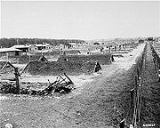
Kaufering concentration camp
Encyclopedia

With the intensification of the Allied
Allies of World War II
The Allies of World War II were the countries that opposed the Axis powers during the Second World War . Former Axis states contributing to the Allied victory are not considered Allied states...
air war
Aerial warfare
Aerial warfare is the use of military aircraft and other flying machines in warfare, including military airlift of cargo to further the national interests as was demonstrated in the Berlin Airlift...
against German
Germany
Germany , officially the Federal Republic of Germany , is a federal parliamentary republic in Europe. The country consists of 16 states while the capital and largest city is Berlin. Germany covers an area of 357,021 km2 and has a largely temperate seasonal climate...
industrial and military enterprises after 1943, the German Armaments Ministry and the Schutzstaffel (SS)
Schutzstaffel
The Schutzstaffel |Sig runes]]) was a major paramilitary organization under Adolf Hitler and the Nazi Party. Built upon the Nazi ideology, the SS under Heinrich Himmler's command was responsible for many of the crimes against humanity during World War II...
agreed to accelerate construction of massive underground factories, using large numbers of conscripted laborers and concentration camp prisoners. Hundreds of satellite camps attached to major Nazi concentration camps
Nazi concentration camps
Nazi Germany maintained concentration camps throughout the territories it controlled. The first Nazi concentration camps set up in Germany were greatly expanded after the Reichstag fire of 1933, and were intended to hold political prisoners and opponents of the regime...
were established throughout the German Reich in 1944 and 1945. Inmates were compelled to hollow out the sides of mountains or caves for immense systems of tunnels and factories that would be secure from Allied bombs. Those who survived these tasks were often used to build new weaponry, such as the Messerschmitt Me 262
Messerschmitt Me 262
The Messerschmitt Me 262 Schwalbe was the world's first operational jet-powered fighter aircraft. Design work started before World War II began, but engine problems prevented the aircraft from attaining operational status with the Luftwaffe until mid-1944...
jet fighter, and V-2 ballistic missile
Ballistic missile
A ballistic missile is a missile that follows a sub-orbital ballistic flightpath with the objective of delivering one or more warheads to a predetermined target. The missile is only guided during the relatively brief initial powered phase of flight and its course is subsequently governed by the...
s.
In Bavaria
Bavaria
Bavaria, formally the Free State of Bavaria is a state of Germany, located in the southeast of Germany. With an area of , it is the largest state by area, forming almost 20% of the total land area of Germany...
, two major camp systems, Mühldorf
Mühldorf subcamp
In mid-1944, the Schutzstaffel established at Mühldorf in Bavaria the Mühldorf camp complex, a satellite system of the Dachau concentration camp to provide labor for an underground installation for the production of the Messerschmitt 262 , a jet fighter designed to challenge Allied air superiority...
and Kaufering, were set up as subcamps of the Dachau concentration camp. Its inmates provided the labor necessary to build subterranean facilities for fighter aircraft production in the Landsberg
Landsberg
Landsberg may refer to:* Landsberg , Bavaria, Germany* Landsberg, Saxony-Anhalt, Germany* the Margraviate of Landsberg, Holy Roman Empire* Landsberg am Lech, Bavaria, Germany* Landsberg an der Warthe, German name of Gorzów Wielkopolski, Poland...
area. The region was chosen in part because of its favorable geological composition for the construction of mammoth underground installations, which were to be insulated by 9 to 15 feet thick concrete walls. To house the concentration camp prisoners, the SS created camps near the proposed industrial sites. At the Kaufering and Mühldorf
Mühldorf
Mühldorf am Inn is a town in Bavaria, Germany, and the capital of the district Mühldorf on the river Inn. It is located at , and had a population of about 17,808 in 2005.-History:...
camps, prisoners often slept in poorly heated and badly provisioned earthen huts, which were partially submerged in the soil and covered with earth to disguise them from the air. The larger of Kaufering's 11 camps each contained several thousand prisoners, the vast majority of whom were Jews
Jews
The Jews , also known as the Jewish people, are a nation and ethnoreligious group originating in the Israelites or Hebrews of the Ancient Near East. The Jewish ethnicity, nationality, and religion are strongly interrelated, as Judaism is the traditional faith of the Jewish nation...
. Disease, malnutrition, and the brutal conditions in the workplace and in the camps took its toll on the inmates, resulting in a high mortality rate.
As U.S. armed forces approached the Kaufering complex in late April 1945, the SS began evacuating the camps, sending the prisoners on death march
Death march
A death march is a forced march of prisoners of war or other captives or deportees. Those marching must walk over long distances for an extremely long period of time and are not supplied with food or water...
es in the direction of Dachau. Those inmates who could not keep up were often shot or beaten to death by the guards. At Kaufering IV, the SS set fire to the barracks killing hundreds of prisoners who were too ill or weak to move.
In popular culture
The liberation of Kaufering was dramatized in the "Why We Fight" episode of Band of Brothers.External links
- European Holocaust Memorial - a monument ensemble against racism and totalitarianism at the place of the crime - under the executive management of European Holocaust Memorial Foundation
- Kaufering USHMM
- Kaufering Kaufering Online Memorial
- The Liberation of the Kaufering IV Hurlach camp, by Japanese-American Nisei troops of the 522nd Field Artillery Battalion

